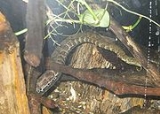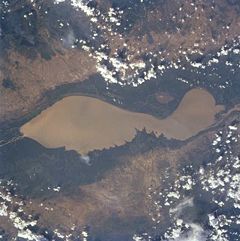
Erpeton Tentaculatum
Encyclopedia
The tentacled snake is a rear-fanged aquatic snake
native to South-East Asia. It is the only species of its genus, Erpeton
, and the two tentacles on its snout are a unique feature among snakes. The method it uses to catch fish
has recently been a subject of research.
The tentacled snake is the only species of snake to possess twin "tentacles" on the front of its head, which have been shown to have mechanosensory function. Its diet consists solely of fish
, although a manuscript from the 1870s suggests that they eat plant matter, probably due to an accidental ingestion.
Although it does have venom
ous fangs, the tentacled snake is not considered dangerous to humans. The fang
s are small, only partially grooved, and positioned deep in the rear of the mouth. The venom
is specific to the fish that the tentacled snake eats.
, Cambodia
, and Vietnam
. The snake lives its entire life in the murky water of lake
s, rice paddies, and slow moving stream
s, and can be found in fresh
, brackish, and sea water. A prime example of its habitat is the Tonlé Sap
lake in central Cambodia. The water there contains much silt and has a large fish population.

The young develop ovoviviparously and are born live underwater.
Hunting is accomplished via a unique ambush
method. Tentacled snakes spend much of their time in a rigid posture. The tail is used to anchor the animal underwater while its body assumes a distinctive upside-down "J" shape. The striking range is a narrow area downwards from its head, somewhat towards its body. Once a fish swims within that area the snake will strike by pulling itself down in one quick motion towards the prey.
Through the use of high-speed cameras and hydrophone
s, the snake's method of ambush is revealed in greater detail. The snake anticipates the movements of the fish as it attempts to escape. As the fish swims into range, the snake creates a disturbance in the water by moving part of its body posterior to the neck. This disturbance triggers an escape reflex in the fish called the C-start, in which the fish contorts its body into a "C" shape. Normally at this point the fish would swim quickly away from the disturbance by quickly straightening its body, but the snake grabs it, usually by the head, anticipating its movement. The snake catches fish by tricking them into reflexively attempting to escape in the wrong direction. Unlike most predators, the snake doesn’t aim for the fish’s initial position and then adjust its direction as the fish moves, it heads directly for the location where it expects the fish’s head to be. The ability to predict the position of its prey appears to be innate.
The tentacled snake retracts its eyes when it begins to strike.
Snake
Snakes are elongate, legless, carnivorous reptiles of the suborder Serpentes that can be distinguished from legless lizards by their lack of eyelids and external ears. Like all squamates, snakes are ectothermic, amniote vertebrates covered in overlapping scales...
native to South-East Asia. It is the only species of its genus, Erpeton
Erpeton
Erpeton is a genus of water snake of the family Colubridae, which includes a single known species, the tentacled snake, Erpeton tentaculatum, which is native to South-East Asia. They are aquatic and extremely fast in catching their prey, small fish...
, and the two tentacles on its snout are a unique feature among snakes. The method it uses to catch fish
Fish
Fish are a paraphyletic group of organisms that consist of all gill-bearing aquatic vertebrate animals that lack limbs with digits. Included in this definition are the living hagfish, lampreys, and cartilaginous and bony fish, as well as various extinct related groups...
has recently been a subject of research.
Description
The tentacled snake is a relatively small snake, averaging about 50 to 90 cm (20-35 inches) in length. They are known to come in two color phases, striped or blotched, with both phases ranging from dark gray or brown to a light tan. It lives its entire life in murky water.The tentacled snake is the only species of snake to possess twin "tentacles" on the front of its head, which have been shown to have mechanosensory function. Its diet consists solely of fish
Fish
Fish are a paraphyletic group of organisms that consist of all gill-bearing aquatic vertebrate animals that lack limbs with digits. Included in this definition are the living hagfish, lampreys, and cartilaginous and bony fish, as well as various extinct related groups...
, although a manuscript from the 1870s suggests that they eat plant matter, probably due to an accidental ingestion.
Although it does have venom
Venom
Venom is the general term referring to any variety of toxins used by certain types of animals that inject it into their victims by the means of a bite or a sting...
ous fangs, the tentacled snake is not considered dangerous to humans. The fang
Fang
Fang is a mammal's canine tooth.Fang may also refer to:* A snake's poison-injecting tooth: see snake venom* Fang people, in Central Africa* Fang language, spoken by Fang people...
s are small, only partially grooved, and positioned deep in the rear of the mouth. The venom
Venom
Venom is the general term referring to any variety of toxins used by certain types of animals that inject it into their victims by the means of a bite or a sting...
is specific to the fish that the tentacled snake eats.
Distribution
A native of South-East Asia, the tentacled snake can be found in ThailandThailand
Thailand , officially the Kingdom of Thailand , formerly known as Siam , is a country located at the centre of the Indochina peninsula and Southeast Asia. It is bordered to the north by Burma and Laos, to the east by Laos and Cambodia, to the south by the Gulf of Thailand and Malaysia, and to the...
, Cambodia
Cambodia
Cambodia , officially known as the Kingdom of Cambodia, is a country located in the southern portion of the Indochina Peninsula in Southeast Asia...
, and Vietnam
Vietnam
Vietnam – sometimes spelled Viet Nam , officially the Socialist Republic of Vietnam – is the easternmost country on the Indochina Peninsula in Southeast Asia. It is bordered by China to the north, Laos to the northwest, Cambodia to the southwest, and the South China Sea –...
. The snake lives its entire life in the murky water of lake
Lake
A lake is a body of relatively still fresh or salt water of considerable size, localized in a basin, that is surrounded by land. Lakes are inland and not part of the ocean and therefore are distinct from lagoons, and are larger and deeper than ponds. Lakes can be contrasted with rivers or streams,...
s, rice paddies, and slow moving stream
Stream
A stream is a body of water with a current, confined within a bed and stream banks. Depending on its locale or certain characteristics, a stream may be referred to as a branch, brook, beck, burn, creek, "crick", gill , kill, lick, rill, river, syke, bayou, rivulet, streamage, wash, run or...
s, and can be found in fresh
Fresh
Fresh is a 1994 crime film written and directed by Boaz Yakin in his film directorial debut, and produced by Lawrence Bender , who at the time was riding the wave of success of Reservoir Dogs...
, brackish, and sea water. A prime example of its habitat is the Tonlé Sap
Tonlé Sap
The Tonlé Sap is a combined lake and river system of major importance to Cambodia.The Tonlé Sap is the largest freshwater lake in South East Asia and is an ecological hot spot that was designated as a UNESCO biosphere in 1997....
lake in central Cambodia. The water there contains much silt and has a large fish population.

Behavior
Tentacled snakes spend their whole life in the water and can stay underwater for up to 30 minutes without coming up for air. They can move only awkwardly on land. In dry times and at night, the snake may burrow itself in the mud.The young develop ovoviviparously and are born live underwater.
Hunting is accomplished via a unique ambush
Ambush predator
Ambush predators or sit-and-wait predators are carnivorous animals that capture prey by stealth or cunning, not by speed or necessarily by strength. These organisms usually hide motionless and wait for prey to come within striking distance. They are often camouflaged, and may be solitary...
method. Tentacled snakes spend much of their time in a rigid posture. The tail is used to anchor the animal underwater while its body assumes a distinctive upside-down "J" shape. The striking range is a narrow area downwards from its head, somewhat towards its body. Once a fish swims within that area the snake will strike by pulling itself down in one quick motion towards the prey.
Through the use of high-speed cameras and hydrophone
Hydrophone
A hydrophone is a microphone designed to be used underwater for recording or listening to underwater sound. Most hydrophones are based on a piezoelectric transducer that generates electricity when subjected to a pressure change...
s, the snake's method of ambush is revealed in greater detail. The snake anticipates the movements of the fish as it attempts to escape. As the fish swims into range, the snake creates a disturbance in the water by moving part of its body posterior to the neck. This disturbance triggers an escape reflex in the fish called the C-start, in which the fish contorts its body into a "C" shape. Normally at this point the fish would swim quickly away from the disturbance by quickly straightening its body, but the snake grabs it, usually by the head, anticipating its movement. The snake catches fish by tricking them into reflexively attempting to escape in the wrong direction. Unlike most predators, the snake doesn’t aim for the fish’s initial position and then adjust its direction as the fish moves, it heads directly for the location where it expects the fish’s head to be. The ability to predict the position of its prey appears to be innate.
The tentacled snake retracts its eyes when it begins to strike.

